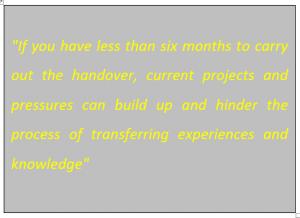Appointing a successor to the CEO from within the business has many advantages to those offered through an outsider, but how do you spot, groom and install such an important figure from your talent pool?
Some of the world’s most successful companies have a cast-iron policy of only ever giving the top job to a member of the existing board when the inevitable happens. Toyota, General Electric and GSK have all historically looked inside when trying to fill the shoes of an outgoing CEO, and with good reason. Internal candidates benefit from a heightened sensitivity to corporate and cultural issues affecting the company, and as such can usually make an impact far sooner than someone from the outside. However, although they will also already know the competition and the market, this should not be a factor in the decision according to Will Dawkins, Head of the Board Practice at executive search firm Odgers Ray & Berndtson: “Some of the most successful succession planning that I’ve done has been very long-term and based on alternative strategic scenarios. It is increasingly the case that the most likely strategic scenario is going to be a complete change in your market and the behaviour of your industry. You may well find that you haven’t developed your internal talent to deal with that; they can deal with the present but not what’s going to happen in the future.”
An excellent example of this kind of vision is the planning undertaken by Reuters’ Chief Executive Sir Christopher Hogg, who spent many years planning the future of the company and the talent needed to run it. He realised that the future was in financial data and not newswires and needed a different kind of leadership – this was a major factor in the decision to appoint Tom Glocer as CEO.
 When appointing internally it is essential that the candidate has undergone a rigorous developmental journey throughout their career, exposing them to different business units, functions and geographies to give them a broad view of the company’s operations. This will eliminate the risk of finding out areas of weakness once installed, which in most cases can be too late. Luckily, the appetite for development roles in ambitious executives is now far greater than ever, as Elizabeth Marx, author and leadership expert explains: “I think in the past a lot of executives relied on a mentor or being tapped on the shoulder. Although you can’t go ahead and announce that you’re going to be a potential successor to the CEO, executives are now much clearer about making sure their successes are known whereas before they weren’t as overt. What is particularly important is that they select the right roles as they move through the organisation – are they high profile, do they hold enough significance within the company and do they allow you to demonstrate your skill set? If you select a new role in a country that no-one hears about, you’ve not got an opportunity for growth or turnaround and that’s not a good platform. Executives are much smarter in terms of what they take on and they are asking for more high profile positions earlier on.”
When appointing internally it is essential that the candidate has undergone a rigorous developmental journey throughout their career, exposing them to different business units, functions and geographies to give them a broad view of the company’s operations. This will eliminate the risk of finding out areas of weakness once installed, which in most cases can be too late. Luckily, the appetite for development roles in ambitious executives is now far greater than ever, as Elizabeth Marx, author and leadership expert explains: “I think in the past a lot of executives relied on a mentor or being tapped on the shoulder. Although you can’t go ahead and announce that you’re going to be a potential successor to the CEO, executives are now much clearer about making sure their successes are known whereas before they weren’t as overt. What is particularly important is that they select the right roles as they move through the organisation – are they high profile, do they hold enough significance within the company and do they allow you to demonstrate your skill set? If you select a new role in a country that no-one hears about, you’ve not got an opportunity for growth or turnaround and that’s not a good platform. Executives are much smarter in terms of what they take on and they are asking for more high profile positions earlier on.”
In terms of the ideal time frame in which a successor should be identified, the general rule is as early as possible. The acclimatising and onboarding period for a new CEO is undoubtedly shorter for an internal successor, but it is still an essential exercise in maintaining corporate stability. Russell Harlow, Principal Consultant at leadership consultancy TMA offers this advice: “Many companies these days are finding rapid market changes and more demanding workforces are challenging the ‘traditional’ way of grooming future CEOs – by succession plans which last five to six years. Employees, high potentials or not, are much more demanding of their employers and creating stable, highly motivational work environments in which talent can flourish and where executive boards can identify the right successors is not easy.
“Typically, we are finding that our global clients are making the choice of successor within a period of six to nine months before departure. If you have less than six months to carry out the handover, current projects and pressures can build up and hinder the process of transferring experiences and knowledge. Transferring the ‘tacit’ knowledge necessary to support technical skills can take time and must not be squeezed in between more overt priorities.”
 Some leading figures in the leadership field, including Harvard professor Joseph Bower, recommend that the earlier you identify a potential successor the better. Indeed, Bower has suggested that you need to have potential candidates earmarked by the time they’re 30, and give them an offshoot of the business to manage that early in their career. Marx disagrees: “No, I don’t share this view at all; that would be a disastrous culture and people have different paces to their careers. What I think is very clear is that the 35-45 window is extremely important, and you could argue that it may veer towards 32 or 33 in a couple of years time, but in my research I haven’t actually found CEOs getting much younger. You still need the years of experience, but if you’re in your mid to late 30s and have the ambition to be CEO, this is the time you should be taking on developmental opportunities.”
Some leading figures in the leadership field, including Harvard professor Joseph Bower, recommend that the earlier you identify a potential successor the better. Indeed, Bower has suggested that you need to have potential candidates earmarked by the time they’re 30, and give them an offshoot of the business to manage that early in their career. Marx disagrees: “No, I don’t share this view at all; that would be a disastrous culture and people have different paces to their careers. What I think is very clear is that the 35-45 window is extremely important, and you could argue that it may veer towards 32 or 33 in a couple of years time, but in my research I haven’t actually found CEOs getting much younger. You still need the years of experience, but if you’re in your mid to late 30s and have the ambition to be CEO, this is the time you should be taking on developmental opportunities.”
Primarily the role of the Chairman and the board, the incumbent Chief Exec certainly has a part to play in putting together the candidate profile and scope of the role, however, as Dawkins agrees “On no account should the outgoing CEO crown their successor, however they should be instrumental in supporting the process. It can also be very dangerous for them to resist the succession planning process, which sometimes results in a terminal experience for them.”
But how to manage the expectations that naturally are raised during any succession process? Although you want to consider as wide a candidate pool as possible, those not offered the role or even those not shortlisted, may well feel resentment towards those handling the process. Harlow comments: “It is very important to be transparent in such situations.  As an employer you want your people to continue to contribute even if this time round they did not secure the role. If your company uses a ranking system in its identification of high-potentials and future leaders, people will want to know the ‘whys’ and ‘why-nots’ behind the scores and decision. Interestingly, one of our global clients, which has just restructured its Performance Management and succession planning system, is finding that senior executives need support and training in coaching skills in order to give such ‘difficult’ feedback effectively. These are exactly the conversations that need to happen but are also the ones most people want to avoid.”
As an employer you want your people to continue to contribute even if this time round they did not secure the role. If your company uses a ranking system in its identification of high-potentials and future leaders, people will want to know the ‘whys’ and ‘why-nots’ behind the scores and decision. Interestingly, one of our global clients, which has just restructured its Performance Management and succession planning system, is finding that senior executives need support and training in coaching skills in order to give such ‘difficult’ feedback effectively. These are exactly the conversations that need to happen but are also the ones most people want to avoid.”
First published by and reproduced with kind permission from The Grapevine Magazine, May 2008
